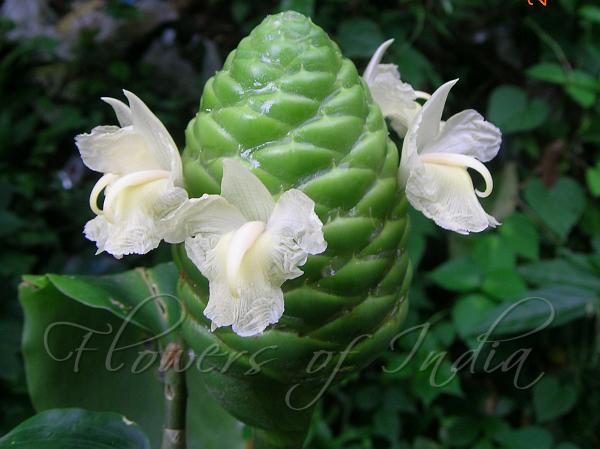|
| Shampoo Ginger |
|

|

| File size | 335931 |
| Original date | 8/20/07 9:07 AM |
| Resolution | 1944 x 1458 |
| Flash | Flash did not fire, auto |
| Focal length | 5.8mm |
| Exposure time | 1/30s |
| Aperture | 3.5 |
| Focus Distance | |
| Metering Mode | Partial |
| Camera make | NIKON |
| Camera model | E5400 |
| Sensor type |
|
|
|
|
Photo: |
Botanical name: Zingiber zerumbet Family: Zingiberaceae (Ginger family)
Synonyms: Amomum zerumbet, Zerumbet zingiber, Amomum silvestre
Synonyms: Amomum zerumbet, Zerumbet zingiber, Amomum silvestre
Shampoo Ginger is a perennial herb characterized by
pinecone-like heads of bracts from which white flowers emerge. On
maturity the heads turns bright red and exude a wonderfully thick
liquid with an equally wonderful fragrance. And, in fact, the liquid
makes an excellent shampoo, thus its common name Shampoo Ginger. The
10-12 elliptic-lanceshaped leaves, 15-20 cm long, grow in an alternate
arrangement on thin, upright stem. Among the leafy stems the conical or
club-shaped flower heads form on separate and shorter stalks. These
appear in the summer, after the leafy stems have been growing for
awile. The flower heads are reddish-green 3-10 cm long with overlapping
scales, enclosing small yellowish-white flowers that poke out a few at
a time. The flowers are inconspicuous, 3-petaled, and creamish in
color. The flower stalks usually remain hidden beneath the leaf stalks.
This plant, originating in India, was distributed eastward through
Polynesia and introduced to the Hawaiian Islands in the canoes of early
Polynesian settlers. Shampoo Ginger grows in moist, shaded, forested
areas.
Medicinal uses:  In Hawaii the spicy-smelling fresh rhizomes were pounded and used as
medicine for indigestion and other ailments. In traditional use, the
rhizome was ground in a stone mortar with a stone pestle, was mixed
with a ripe Noni fruit and then used to treat severe sprains. The pulp
was placed in a cloth and loosely bound around the injured area. For a
toothache or a cavity, the cooked and softened rhizome was pressed into
the hollow and left for as long as was needed. To ease a stomach ache,
the ground and strained rhizome material is mixed with water and drunk.
In Hawaii the spicy-smelling fresh rhizomes were pounded and used as
medicine for indigestion and other ailments. In traditional use, the
rhizome was ground in a stone mortar with a stone pestle, was mixed
with a ripe Noni fruit and then used to treat severe sprains. The pulp
was placed in a cloth and loosely bound around the injured area. For a
toothache or a cavity, the cooked and softened rhizome was pressed into
the hollow and left for as long as was needed. To ease a stomach ache,
the ground and strained rhizome material is mixed with water and drunk.
 In Hawaii the spicy-smelling fresh rhizomes were pounded and used as
medicine for indigestion and other ailments. In traditional use, the
rhizome was ground in a stone mortar with a stone pestle, was mixed
with a ripe Noni fruit and then used to treat severe sprains. The pulp
was placed in a cloth and loosely bound around the injured area. For a
toothache or a cavity, the cooked and softened rhizome was pressed into
the hollow and left for as long as was needed. To ease a stomach ache,
the ground and strained rhizome material is mixed with water and drunk.
In Hawaii the spicy-smelling fresh rhizomes were pounded and used as
medicine for indigestion and other ailments. In traditional use, the
rhizome was ground in a stone mortar with a stone pestle, was mixed
with a ripe Noni fruit and then used to treat severe sprains. The pulp
was placed in a cloth and loosely bound around the injured area. For a
toothache or a cavity, the cooked and softened rhizome was pressed into
the hollow and left for as long as was needed. To ease a stomach ache,
the ground and strained rhizome material is mixed with water and drunk.
| Identification credit: Tabish | Photographed in Kannur distt., Kerala & Pasighat, Arunachal Pradesh. |
• Is this flower misidentified? If yes,